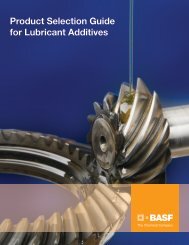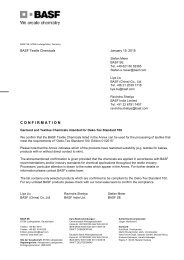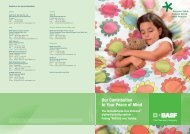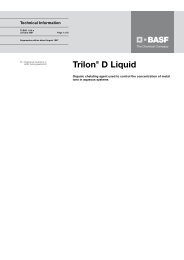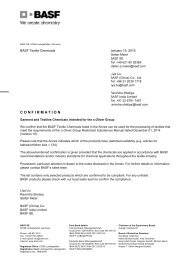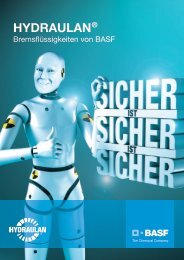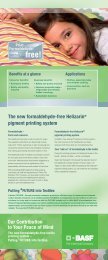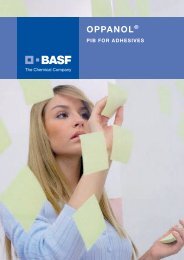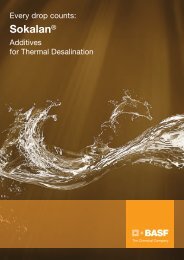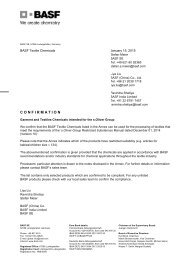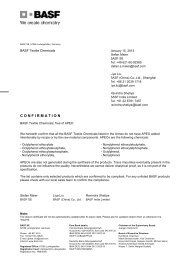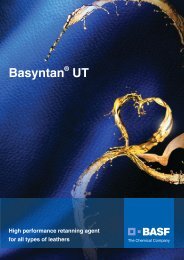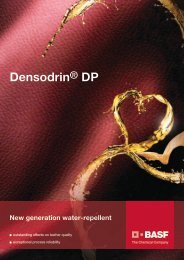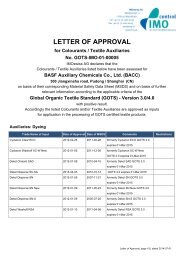'Anti'-finish automotive leather - Performance Chemicals
'Anti'-finish automotive leather - Performance Chemicals
'Anti'-finish automotive leather - Performance Chemicals
You also want an ePaper? Increase the reach of your titles
YUMPU automatically turns print PDFs into web optimized ePapers that Google loves.
Technology | Automotive <strong>leather</strong><br />
‘Anti’-<strong>finish</strong> <strong>automotive</strong><br />
<strong>leather</strong> – vision and<br />
contradiction<br />
By Dr Brigitte Wegner and Dr Gerhard Wolf, BASF SE<br />
Car manufacturers have been paying increasing attention<br />
to <strong>automotive</strong> interiors in recent years because they are<br />
seeking to distance themselves from their competitors<br />
and to create a specific image for their brand. Consumers are<br />
encouraged to treat the interior of their vehicles like their own<br />
living room, with an individual design and high standards of<br />
comfort and serviceability.<br />
As many different materials are used in <strong>automotive</strong> interiors<br />
<strong>leather</strong> is in competition with textiles, synthetics, Alcantara etc.<br />
The question here is what distinguishes <strong>leather</strong> from other<br />
materials, and the simple answer is the natural feel and natural<br />
appearance. It is this feature that is primarily responsible for<br />
<strong>leather</strong>’s image as a luxury, premium-grade material. Leather will<br />
have to retain its natural character if it is to defend its position in<br />
the market, but this conflicts with the market’s demands for other<br />
features such as resistance to abrasion, etc.<br />
BASF’s ‘anti’-<strong>finish</strong> concept for <strong>automotive</strong> interiors is an<br />
approach that makes it possible to pursue a long-term vision for<br />
<strong>automotive</strong> <strong>leather</strong> while, at the same time, fulfilling the shortterm<br />
demands of original equipment manufacturers (OEMs). In<br />
<strong>finish</strong>ing, the aim must always be to retain the natural character<br />
of the <strong>leather</strong>, ideally by dispensing with the <strong>finish</strong> altogether or,<br />
at least, by reducing the amount of <strong>finish</strong> or making it invisible.<br />
The underlying premise is that applying less <strong>finish</strong> or ‘anti’-<strong>finish</strong><br />
adds more value to the <strong>leather</strong>.<br />
These demands are certainly not easy to satisfy, but they<br />
represent the current trend in the market for <strong>automotive</strong> <strong>leather</strong><br />
in Europe and increasingly in North America and Asia. The goal<br />
of the <strong>leather</strong> industry has to be to develop ‘anti’-<strong>finish</strong>es that<br />
will maintain and enhance the image of <strong>leather</strong> as a premium-<br />
Figure 1. Requirements<br />
38<br />
Challenge<br />
Comfort<br />
Design<br />
Ecology<br />
OEM-Specs<br />
Competition by<br />
other materials<br />
Long term<br />
BASF - Anti-Finishing<br />
‘Anti....as you want’<br />
Short term<br />
Vision<br />
Daily<br />
work<br />
quality material. Improved seating comfort, a better feel and<br />
visual appearance are important arguments. Manufacturers along<br />
the whole <strong>leather</strong> value chain should have a vital interest in<br />
developing this ‘anti’-<strong>finish</strong> concept for <strong>automotive</strong> interiors. But<br />
as well as pursuing a long-term vision, manufacturers also need<br />
to pay attention to the short-term, daily demands of the OEMs.<br />
Apart from the visual appearance and feel of the <strong>leather</strong>, most<br />
demands concentrate on physical fastness and serviceability.<br />
These demands can be summarised under the prefix ‘anti’, ie<br />
anti-squeak, anti-soiling, anti-hydrolysis and anti-abrasion. As<br />
shown in figure 2 this can be further extended and ecological<br />
demands can also be illustrated with ‘anti’ terms like antiemission,<br />
anti-RSL (restricted substance list), anti-CO2 and antideforestation.<br />
BASF’s ‘anti’-<strong>finish</strong> concept can be applied flexibly<br />
according to what is demanded. There is often no ideal solution<br />
but at least it illustrates the problems and unresolved issues and<br />
makes a solution easier to find.<br />
‘Anti’-squeak<br />
There has been a large reduction in the overall noise level of<br />
motor vehicles in recent years. This has prompted increasing<br />
demands, especially from manufacturers of premium brands in<br />
Europe, to eliminate the interior noise caused by squeaks. It<br />
remains to be seen whether other manufacturers in Asia and<br />
North America will follow suit in the future.<br />
Squeaks are caused by friction between <strong>leather</strong> and other<br />
surfaces in the interior of the vehicle, including the driver. The<br />
BASF Novomatt system with its special additives has proved to<br />
be very effective for eliminating squeaks.<br />
Figure 3 shows a comparison between standard <strong>leather</strong> and<br />
Figure 2. ‘Anti’-<strong>finish</strong>ing<br />
Anti-RSL<br />
Anti-tox<br />
Anti-emission<br />
Anti-CO2/-CF<br />
Anti-waste AAnti-deforestation<br />
Anti-squeak<br />
Anti-overspray Anti-energy<br />
‘Anti....as you want’<br />
Anti-soiling<br />
Anti-???<br />
Anti-Finishing<br />
Anti-hydrolysis<br />
A ti h d l i<br />
Anti-shrink<br />
Anti-abrasion<br />
Anti-ageing<br />
A<br />
Anti-’polishing’<br />
LEATHER INTERNATIONAL | www.<strong>leather</strong>mag.com July 2011
less squeaky <strong>leather</strong> tested with a Stick Slip Tester according to<br />
VDA 230-206. The smaller the deflection of the oscilloscope, the<br />
less friction is generated and there is less noise.<br />
‘Anti’-soiling<br />
There is also a general trend away from black <strong>leather</strong> trim towards<br />
brighter, more attractive colours, and this will increase in future.<br />
This trend reflects the move towards more individualised vehicle<br />
interiors, such as using brighter colours. Therefore, one of the<br />
most frequently discussed problems is how to make <strong>leather</strong> more<br />
resistant to soiling and easier to clean, and it is also one of the<br />
most difficult problems to solve. First, because ‘each’ OEM has<br />
their own ideas about soiling and their own specifications. The<br />
second reason is that the chemical structure of all the different<br />
types of soil can vary widely from fatty, hydrophobic soil such as<br />
butter and ketchup etc, through to hydrophilic soil such as coffee<br />
and dyes. The <strong>leather</strong> also has to be resistant to inorganic soil<br />
such as soot, dust and silicates and to organic soil such as urine,<br />
blood and saliva. The chemical bonds that all these different types<br />
of soil form with the surface of the <strong>leather</strong> can be very diverse.<br />
These range from simple adhesion, via ionic bonds and hydrogen<br />
bonds through to stable covalent bonds.<br />
There is no single effective solution to the problem of<br />
improving the soiling resistance of <strong>leather</strong> and making it easier to<br />
clean. Therefore, BASF offer customers an ‘anti-soiling toolbox’<br />
consisting of products with a wide range of different chemical<br />
structures. Figure 3 shows the results obtained in the Martindale<br />
test (VDA 230-212) as an example.<br />
‘Anti’-abrasion<br />
Abrasion is a recognised problem, especially the wear caused to<br />
seats by passengers. Generally <strong>leather</strong> is more resistant to<br />
abrasion if the <strong>finish</strong> is hard and smooth and applied as thickly as<br />
possible. However, this contradicts the trend towards natural<br />
<strong>leather</strong> and the concept of ‘anti’-<strong>finish</strong> systems. Abrasion<br />
resistance is a particularly important topic for OEMs in Japan and<br />
the US. This is reflected in the wide variety of test methods, such<br />
as the Gakuschin (Japan), Wyzenbek (US) and Taber methods (US,<br />
Asia, EU). The Taber, Ball Plate and Mie tests have established<br />
themselves in Europe. Compromises have to be made and some<br />
performance in abrasion tests will have to be sacrificed in order<br />
to retain the natural feel of the <strong>leather</strong>.<br />
Figure 4 shows the yellowing resistance of <strong>leather</strong> treated<br />
with a standard <strong>finish</strong> and <strong>leather</strong> treated with an optimised<br />
<strong>finish</strong> after 400 hours at 110°C. This is currently the most<br />
demanding test method on the market.<br />
‘Anti’-ageing and ‘Anti’-hydrolysis<br />
Automotive <strong>leather</strong> is used together with other materials such as<br />
metals and plastics in <strong>automotive</strong> interiors, and these materials are<br />
so resistant to ageing that <strong>leather</strong> can hardly begin to compete.<br />
Leather is a natural material and its structure makes it prone to<br />
ageing, but specially adapted <strong>finish</strong>ing systems can be developed<br />
to improve its resistance to ageing. Very specific solutions have to<br />
be developed for each OEM because the demands vary very widely,<br />
as do the test methods by which these demands are assessed.<br />
Anti-hydrolysis or the resistance of <strong>leather</strong> to ageing by<br />
hydrolysis is a special case because it is tested at high humidity and<br />
July 2011<br />
Automotive <strong>leather</strong> | Technology<br />
Figure 3. Anti-squeak and anti-soiling<br />
Anti-squeak, slip-stick-test Anti-soiling<br />
VDA 230-206<br />
VDA 230-2122<br />
Quiet<br />
Noisy<br />
Standard<br />
New<br />
Grey scale<br />
Low Change in colour High g<br />
2<br />
3<br />
4<br />
Figure 4. Anti-abrasion and anti-ageing<br />
Standard Standard New New<br />
BASF �nish with Astacin® Novomatt +<br />
Lepton® Protector<br />
Industry standard<br />
5<br />
1000x<br />
1000x<br />
Rub cycles with denim in Martindale test<br />
Anti-abrasion<br />
Anti-ageing<br />
Taber-test Heat yellowing<br />
(DIN ( EN 14327) )<br />
acc. to Toyota, y , 100ºC, , 400h<br />
With<br />
damage<br />
Without Without<br />
damage damage<br />
high temperature. It can be assessed by observing changes in<br />
colour, flexometer values, surface area, surface texture and softness.<br />
The ageing resistance of <strong>leather</strong> depends to a significant<br />
extent on the crust. High-quality crust has high lightfastness<br />
and there is no migration, shrinkage or hardening under the test<br />
conditions. It is essential that these premises be met in order to<br />
obtain the best results. The products contained in <strong>finish</strong>es have to<br />
remain stable, especially at high temperatures and high humidity.<br />
Acrylic polymers and polyurethanes based on polyethers and<br />
polycarbonates have been found to perform very reliably, and these<br />
are marketed by BASF under their Corial and Astacin brands.<br />
‘Anti’-emission<br />
Reducing overall emissions from <strong>leather</strong> is a complex undertaking<br />
with many different facets. The original reason for reducing<br />
emissions in vehicle interiors was to prevent the windows from<br />
being fogged by volatile substances. These efforts were then<br />
extended to cover volatile organic carbon (VOC), and a chemical<br />
analysis was made of the substances released in the interior of<br />
vehicles. OEMs have been very imaginative and have devised a<br />
whole host of test methods for volatile organic compounds with<br />
the result that greater attention has been paid to the individual<br />
substances that are released into the ambient air and to issues<br />
relevant to health. The most prominent example is the discussion<br />
concerning formaldehyde in <strong>leather</strong>, and the limits on<br />
www.<strong>leather</strong>mag.com | LEATHER INTERNATIONAL<br />
39
Technology | Automotive <strong>leather</strong><br />
Figure 5. NMP<br />
formaldehyde have gradually been made more stringent over the<br />
past ten years.<br />
A more recent example is the discussion concerning Nmethylpyrrolidone<br />
(NMP) in <strong>leather</strong>. NMP is a solvent that has<br />
been used as an ingredient in <strong>finish</strong>ing products and also directly<br />
in production processes. The use of NMP was novel but it has<br />
since come under pressure for toxicological reasons.<br />
The first attempt at eliminating NMP was to replace it with Nethylpyrrolidone<br />
(NEP). This certainly made sense from the point<br />
of view of technology but not from the point of view of toxicology<br />
because NEP is also not free of toxicological problems. It must be<br />
emphasised that both solvents, NMP and NEP, can be detected<br />
fairly easily by measuring the VOC.<br />
Because NMP and NEP are so easy to detect, it is likely that<br />
OEMs will set a limit of zero for these substances in their<br />
specifications, ie below the threshold of detectability. A difference<br />
between NMP, NEP and formaldehyde is that the sources of these<br />
two solvents can be identified very easily and they can be replaced<br />
with other solvents. NMP and NEP are employed in the manufacture<br />
of <strong>finish</strong>ing products for technical reasons but they are also added to<br />
<strong>finish</strong>ing formulations in order to improve their performance. BASF<br />
have responded to this challenge and now supply a range of<br />
products for <strong>finish</strong>ing <strong>automotive</strong> <strong>leather</strong> that is completely free of<br />
NMP and NEP.<br />
BASF’s <strong>automotive</strong> products<br />
Another challenge is to reduce the carbon footprint by preventing<br />
the release of greenhouse gases, predominately CO2. These<br />
indirect emissions are predominately caused by the consumption<br />
of energy in the form of fossil fuels. Carbon footprint is a very<br />
40<br />
N-Methyl-2-Pyrrolidone<br />
O<br />
N<br />
(pure product)<br />
CH3<br />
Formulations<br />
> 5 to 10% NMP<br />
10 – 20% NMP<br />
> 20% NMP<br />
Figure 6. NEP<br />
NEP=N-Ethyl-pyrrolidone<br />
O<br />
CH2CH3<br />
N<br />
(pure product)<br />
Formulations<br />
> 1 to 3% NEP<br />
H360D: May damage the<br />
unborn child.<br />
H315: Causes skin irritation<br />
H319: Causes serious eye<br />
irritation<br />
H335: May cause<br />
respiratory irritation<br />
H360D<br />
Hazard statements Pictograms<br />
H315, H319, H360D<br />
H315, H319, H360D, H335<br />
H318: Cause serious<br />
eye damage.<br />
H361d: Suspected of<br />
damaging the<br />
unborn child.<br />
H319: Cause serious<br />
eye irritation.<br />
> 3% NEP H318 and H261d<br />
Hazard statements Pictograms<br />
Figure 7a. BASF <strong>automotive</strong> range<br />
Binders<br />
Corial ® Binder DN Astacin Finish PE Astacin Finish PUM<br />
Corial Ultrasoft NT Astacin Finish PR Astacin Finish PUMN TF<br />
Astacin ® Ground UH TF<br />
Top coats<br />
Astacin Finish PS Astacin Finish SUSI TF<br />
Lepton ® Matting EO Astacin Matting HS Astacin Novomatt GG<br />
Lepton ® Top LC<br />
Crosslinkers<br />
Astacin Matting LV TF<br />
Astacin Matting MT<br />
Astacin Novomatt DM<br />
Astacin Hardener CN Astacin Hardener CI Astacin Hardener CA<br />
Figure 7a. BASF <strong>automotive</strong> range<br />
Filters/oils/waxes<br />
Lepton ® Enhancer CP Eukesol ® Oil Ground Lepton Wax A<br />
Lepton Enhancer LT Luron ® Matting Lepton Filler FCG<br />
Lepton Matting LB-F Lepton Additive TL<br />
Lepton Matting AL<br />
Levelling agents<br />
Lepton Paste VL<br />
Amolian ® VM<br />
Handle modifiers<br />
Amolian SW Amolian VC<br />
Lepton Wax WN Lepton Wax DS Corial Wax TA<br />
Lepton Protector SR Lepton Wax HM<br />
important topic for the <strong>automotive</strong> industry because it has often<br />
been accused of being one of the main perpetrators of global<br />
warming and all its negative consequences. In Germany for<br />
instance, the global warming potential of all new vehicles has to<br />
be quoted as a CO2 equivalent value. The <strong>leather</strong> industry, in<br />
particular manufacturers of <strong>automotive</strong> <strong>leather</strong>, will eventually be<br />
forced to address this issue and quantify the global warming<br />
potential of <strong>leather</strong> in the form of the CO2 equivalent value per<br />
unit area. This is a new challenge and it is one that BASF are<br />
intensively pursuing as part of their ‘anti’-<strong>finish</strong> concept. The<br />
vision here is to reduce the carbon footprint by manufacturing<br />
<strong>leather</strong> that is carbon-neutral and environmentally friendly.<br />
Conclusion<br />
BASF’s ‘anti’-<strong>finish</strong> concept offers a means of analysing and<br />
structuring the many different visions and concepts for<br />
<strong>automotive</strong> <strong>leather</strong>. Solutions have already been identified in<br />
some areas, but intensive research and development will be<br />
required in others until satisfactory results can be obtained. The<br />
aim of all these efforts has to be to safeguard and foster the<br />
image of <strong>leather</strong> as a premium-quality material with a natural<br />
character. This is part of the overall challenge facing the <strong>leather</strong><br />
industry, which is to ensure that other materials do not replace<br />
<strong>leather</strong>.<br />
Acknowledgements<br />
For great support the authors thank their colleagues Bernd<br />
Schroedelsecker, Klaus Machauer, Leo Derichs and Helfried Scheid.<br />
LEATHER INTERNATIONAL | www.<strong>leather</strong>mag.com July 2011



